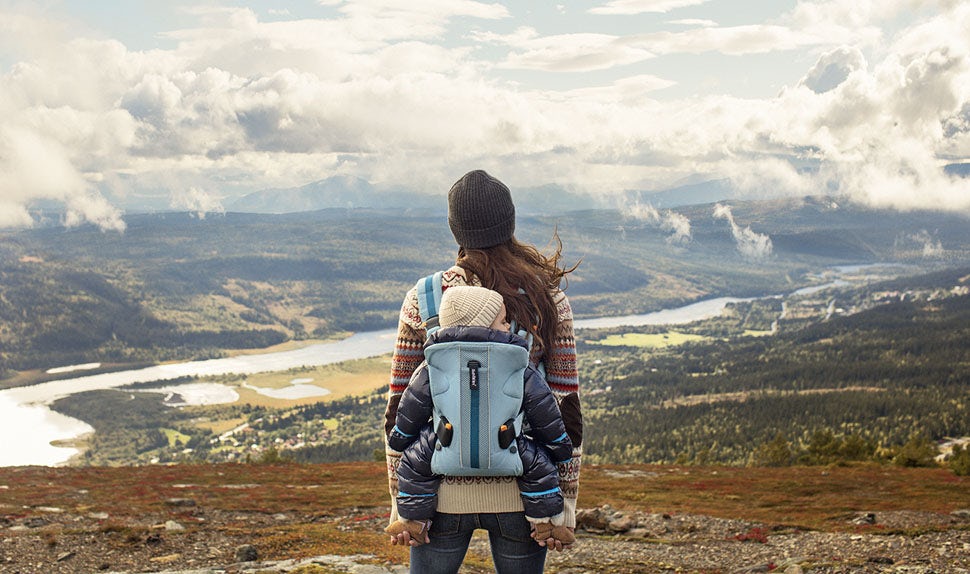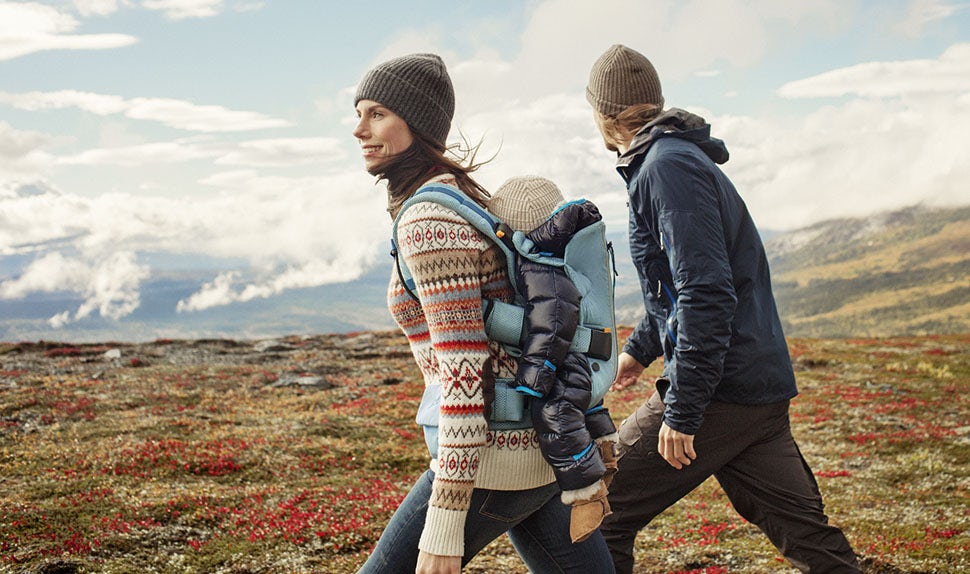
If you're an avid outdoors person, don't let having a baby or toddler stop you from getting out and about in the wilderness. Hiking in the hills, beside a lake or through the woods is made all the more special when you can share it with your baby. After all, they love nothing more than being snuggled up against you, regardless of where you are!
What are the best back baby carriers for hiking?
The broadest answer is ‘one that you find comfortable’. But we’ll be much more specific than that though.
Whether you’re taking a hike into town or the more literal ‘hike’ across moors, mountains or hills, there are so many baby carriers available to you and your little one, or indeed that are suitable for your family as a whole (i.e. one that suits both you and your partner, for example).
With such a vast selection, it means there is a great range in terms of budget, design and style. You may already have one that you've used with a newborn, and this may still be the one you'll use when you're out hiking.
The questions you have will include: which is the best baby back carrier for hiking?; which is best for you?; which one should you choose? There are a few things to take into account - help to narrow your choice down by considering:
- your budget
- your lifestyle
- the age of your baby
- who will be using the sling
Once you have an answer for the above, it will be so easy to pick out the best option for you. For example, will you be out hiking every weekend or only occasionally? Is your baby young or will you be carrying a toddler? Will the carrier be used by you or your partner, or both of you?
As we’ve discussed, the selection is huge, but as we're looking specifically at baby back carriers, we’re going to focus on 3 specific styles:
- Buckle Carriers
- Half Buckle Carriers
- Onbu Carriers
You'll notice that we're only considering high quality baby carriers made from premium fabrics that keep baby's hips in an ergonomic position and that support the natural curve of baby's spine, rather than the ultra-structured steel frame back carriers.
Buckle Carriers
Buckle carriers would be the most popular style of back baby carrier for hiking. More padding, more buckles and more overall structure that give great support and comfort for long treks.
A really good buckle carrier will allow you to carry your little one in such a way as to be respectful of their physiology. Their back should be soft, yet supported - not stiff or rigid. Their legs should be supported all the way along the thigh, to the knee pit, with heir bottom lower than their knees - traditionally, this is called the ‘spread squat position’ or ‘M’ position, but is often defined now as the ‘hip healthy position’. Baby's head should be free, clear and unobstructed. Buckle carriers are versatile and relatively easy to learn. The basic design is a front panel, where baby is ‘seated’ in an upright position, a waist strap and two padded loop shoulder straps, all of which are adjustable to achieve a comfortable fit, and secured with buckles.
Buckle carriers definitely have the greatest selection in terms of brands and designs. We’ve made it simple by choosing 2 of the best, right here:
- Love & Carry One+ - we’ve chosen this option as the ‘from newborn’ option. It works brilliantly right through to 2 years. Even better - if you’re hiking in the warmer months, choose the ‘Cool’ version - it has a rollaway section with a mesh panel behind which helps keep both you and baby cool on warm walks.
- Kibi Carrier - this option works from 4 months right through to 5 years - plenty of time for oodles of hiking! It can easily be used on the back, and transitions as baby grows into a toddler then preschooler.
Half Buckle Carriers
Halfway between a full buckle carrier and a meh dai carrier, a half buckle carrier offers the ease of a clip buckle at the waist, with the adjustability of long shoulder straps for a truly snug fit, without the reaching for back or side clips. Front, hip and back carrying, most are suitable from newborn. They are a wonderful option if you'd like a little more structure for ease of use, but want something mouldable, soft and wrap-like.
Half Buckles are a fantastic option if you want to be able to use one carrier between 2 people. There is maximum adjustability between wearers and far less webbing and buckles to adjust between wearers too. These are our 2 top picks for half buckles:
- Didyklick - the most popular half buckle; it’s comfy, easy to use and supremely adjustable for a snug fit, from XS to XL. Great for days out hiking as you can easily take it on and off when you need to.
- Love & Carry Half Buckle - an amazing budget option but it’s definitely not a budget option in terms of quality or design. It’s compact and well-designed.
Onbus
The Onbuhimo carrier is worn up high on the back and is designed for babies, toddlers, and children who can sit unassisted. It's fast and easy to put on and take off - great for toddlers who can't decide whether they want to be up or down or up!
We all know that toddlers love to explore the world on their own once they can crawl or walk. But as independent as they seem, there are times when they also love (and need) to be carried and held close to you. The Onbuhimo is worn exclusively on the back and doesn't have a waist belt - great if you find a waist belt uncomfortable, or if you're pregnant, there's no waistband to put pressure on your growing tummy. Great too for staying comfortable when hiking outdoors.
The DidyGo Onbuhimo baby carrier is a great way to fill that need. Made from the same high quality fabric as Didymos baby wraps, the DidyGo Onbuhimo perfectly supports your child's back and holds them in a healthy and safe position. It is individually adjustable and easy to handle, allowing for close, connected toddler wearing, and made all the more special when you can share outdoor wonders with someone close to your heart.

Things to Remember When Hiking With Babies or Toddlers
- Go at their pace, if they're walking. If they want to explore something, make time to do so.
- Have plenty of stops – if required. If they are happy carrying on, don’t force a stop – they may not get started again so easily.
- Pick a route with interesting things in it. Some challenges, such as crossing a small stream, make it fun.
- Take snacks to keep their energy up.
- Use distraction techniques. Point things out to them and make it interesting.
- When walking with your baby in a carrier, take it easy on yourself.
 5,467 Reviews
5,467 Reviews